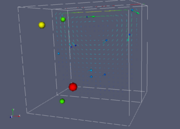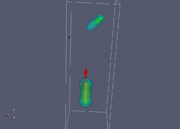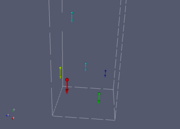Difference between revisions of "Contrib icoLagrangianFoam"
m (Spam removed) |
m |
||
| Line 10: | Line 10: | ||
This code works with the vanilla 1.2 executables. The problem is that not all the data of the particles is output. Applying [[bug_OF12_lagrangian_output|this fix]] and recompiling OpenFOAM makes everything work. | This code works with the vanilla 1.2 executables. The problem is that not all the data of the particles is output. Applying [[bug_OF12_lagrangian_output|this fix]] and recompiling OpenFOAM makes everything work. | ||
| + | |||
| + | === Post-Processing === | ||
| + | |||
| + | [[paraFoam]] can't display the particles, but [[paraview]] can. Look at [[Main_FAQ#Postprocessing_of_Lagrangian_particles|Postprocessing of Lagrangian particles in the FAQ]] | ||
== Physics == | == Physics == | ||
Revision as of 21:23, 21 March 2006
Contents
1 Short description
A solver for incompressible flow and hard particles
2 Usage
Used like icoFoam but has an additional file cloudProperties for the specification of the particles and their injection.
This code works with the vanilla 1.2 executables. The problem is that not all the data of the particles is output. Applying this fix and recompiling OpenFOAM makes everything work.
2.1 Post-Processing
paraFoam can't display the particles, but paraview can. Look at Postprocessing of Lagrangian particles in the FAQ
3 Physics
The particle code is a heavily lobotomized version of stuff found in the dieselSpray classes. It features:
- a simple random injector
- a drag force model that is horrible and not very physical
- particles can bounce from walls or die (switchable)
- particles leave the system at in or outlet. All other boundary types are not treat correctly
- the particles can add a source term to the moment equation of the gas (switchable)
- there is no particle-particle interaction
This solver is not to be used for simulations that resemble the real world. It's just a demo.
4 Example cases
4.1 Driven cavity
This case is a three-dimensional driven cavity. Particles are injected in the middle. They don't perturbate the gas velocity.
The state at the end of the simulation can be seen on the right:
- Gas velocity is shown by a plane of glyphs
- Particles are shown by balls scaled according to their diameter. The velocity of the particle is shown by an arrow
Heavy particles have a tendency to settle at the bottom.
4.2 Open box
In this case a box with walls on five sides and a pressure outlet at the top is calculated. There is no initial velocity of the gas. Particles are eject upward and they perturbate the flow field. Some of the particles (the heavier ones) leave the box at the top. The others fall to the bottom of the box.
On the left a picture from the start of the simulation: it shows
- the particles and their current velocity
- isosurfaces of the regions where the gas has a non-zero velocity
On the right a picture from the end of the simulation. Particles are falling with different terminal velocities depending on their size.
5 Download
--Bgschaid 10:35, 11 Nov 2005 (CET)


